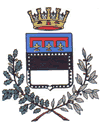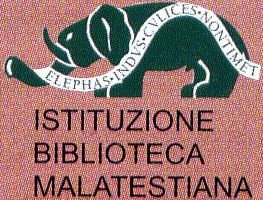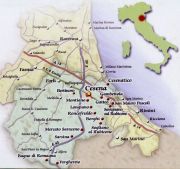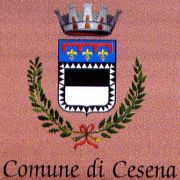LA BIBLIOTECA
MALATESTIANA
|
THE MALATESTA NOVELLO LIBRARY
The Malatestiana is the only example of a monastic humanist library, perfectly preserved in the building, furnishings and book collection, as UNESCO acknowledged by its inclusion in the Memory of the World Register, the first in Italy.
The idea of the library is attributed to the friars of St. Francis, who intended to construct one for use as a studium, annexed to their 14th century monastery.
For this purpose, in 1445 they received permission from Pope Eugene IV to make use of a bequeath and began work on the building, probably in 1447.
In 1450 the initial participation of Malatesta Novello was documented, a Cesena noble who adopted the friars' project and constructed his own library in their monastery.
The model inaugurated by Michelozzo (1444) in the Dominican monastic library of St. Mark in Florence inspired the Malatestiana in Cesena, upon which Matteo Nuti, glorified to alter-Daedalus in lhe epigraph seen by the entrance, laid his insignia: “MCCCCLII Matheus Nutius Fanensi ex urbe creatus Dedalus alter opus tantum deduxit ad unguem" (1452. Matteo Nuti, born in Fano, known as Daedalus, brought such an opus into being).
Crowning the tympanum of the portal is the elephant, emblem of the Malatesta family, with the motto “Elephas Indus culices non timet” (The elephant fears not the culidae - a genus of the mosquito), whilst to the sides of the architrave and on the pilaster capitals there are the heraldic coats of arms showing the pícket fence, three heads and chequy.
The dark wooden door ís the work of Cristoforo da San Giovanni in Persiceto and dated 15 August 1454, a solemn and festive day for the town which in that period celebrated the important fair of “fiera d'agosto".
The carvings, the Gothíc style, repeat rosette motifs and helixes, laid out in such a way as to recall the Malatesta chequy.
The Malatesta coat of arms is also reproduced in the interior, on the capitals of columns in the hall and on the 58 pluteuses (29 each side), the imposing wooden desks in whích the codices are held.
The creation of this harmonious, light-filled hall does not seem greatly different to that of the designer of the Malatesta Temple in Rimini, Leon Battista Alberti, with similarities in a whole series of geometric and proportionate relationships in the layout and elevation of the building, reminiscent of the new Renaissance culture of perspective codified in the De re aedifìcatoria, a celebrated architectural treatise also by Alberti.
Absolutely innovative, in fact, is the triple nave plan, all three with vaulted ceilings: the central vault barrelled, with slightly wider and lower cross vaults to the sides.
The light, distributed through ogival arch windows, two per span, spreads along the side naves, whereas for the central nave, marked by twenty elegant columns with escutcheoned, pendent-leaved capitals, is lit longitudinally by the great oculus in the end wall.
From here a fascínating beam of light falls on the floor epigraphs, commemorating the donor: “Mal(atesta) Nov(ellus) Pan(dulphi) fil(ius) Mal(atestae) nep(os) dedit” (Malatesta Novello son of Pandolfo grandson of Malatesta gaveth).
Even the colour plays a precise role: the white of the central columns, the red of the terracotta floor and half columns, and the green of the plastering, brought back to light in the 1920s, redolent of the colours of the Malatesta family coats of arms.
To equip hís collection with a series of volumes adequate and appropriate for the planned líbrary, the Cesena noble appointed a scribe who, through well organízed and planned tasks, in a time span of around twenty years produced over a hundred and twenty codices.
The collection is inspired by the humanist model in both its littera scripta, albeit certain codices are in Gothic or semi-Gothic script, and in its texts whích include classic authors, Doctors of the Church and translated Greek works, wíth a particular predilection for the historians and the discoveries of contemporary humanists.
Memorable among the scribes were Jean d'Epinal who copíed at least thirty-six codices, Jacopo della Pergola to whom Malatesta Novello entrusted the transcription of onerous works such as the splendid De civitate Dei by Saint Augustine (D.IX.1), and also Brother Francesco di Bartolomeo from Figline, who was also the first custodian of the library.
Among the Malatesta copyists used mainly for the humanist works, also worthy of mention is Andrea Catrinello from Genoa who undersigned one of the copied codices on the day Malatesta Novello died (20 November 1465).
Along with this group of scribes, also active at the court of the Cesena noble were another six or seven Nordíc writers who used the Gothic script.
Among these, the German Mathias Kuler, who in the explicit to the S.IX.3 described himself as a lover of the good life and pleasures of the company of women: "Amen. Bonum vinum in taberna, consortia mulierum consumpserunt omnia. Venite exultemus".
At the behest of a single patron and produced in a short time, the collection has a strongly systematic, encyclopaedic character, since it is destined not for the personal interest of the commissioner, but lo the studies of an entire community.
This unitary character is also evident in the manuscript decoration.
Malatesta Novello declared his role as promoter, instructing that each initial page of every codex should bear his richly and antiquely decorated coat of arms, and the initials M. N. depicted in gold or other colour on a rectangular, gold leaf background.
The manuscripts commissioned or acquired by Malatesta Novello (around 150 specimens) therefore integrated with the pre-existing monastic setting, composed in the 14th century yet rich in even older codices, such as the 9th century Etymologiae of Saint Isidore (S.XXI.5).
Added lo the collection were medical and scientific texts, and also literature and philosophic texts, donated by Giovanní di Marco from Rimini, doctor lo Malatesta Noveìlo and an equally enthusiastíc collector of codices.
Fourteen Greek codices, very likely acquired by Malatesta Novello in Constantinople, seven Hebrew codices and others donated to Novello, plus a number of other codices added in later centuries complete the collection, which totals 343 manuscripts.
Still today, the volumes are held in their desk, which the dual role of an inclined lectern and deposit for books on the shelf below.
Here the codices, normally five per pluteus and subdivided by subject, are laid horizontally and bound to the desks with wrought iron chains.
This habit was probably born from the necessity to provide adequate protection for such precious books.
The Cesena noble, who perceived the Library as an undying symbol of his renown for posterity, ordered, by an entirely original and intuitive decision, that the library also be entrusted to the care and attention of the Cesena community.
In fact, already in 1461 the municipal council began to perform rigorous controls every two months on books held in the pluteuses.
In 1466, after the death of Malatesta Novello, the council even obtained permission to excommunicate anyone removing the codices.
Double control of the collection therefore developed, one by its custodians of St. Francis Monastery who guaranteed its use, and the other by the local Council, who supervised its integrity and respect.
Nomination of the custodian-librarian, according to the wishes of Malatesta Novello, also fell to the municipal council.
In this way the history of the Malatesta Novello Library and its prodigious preservation, which still today represents the greatest pride of Cesena, is also the history of a symbol felt to be the property of, and loved with exceptional loyalty by, Cesena citizens.




